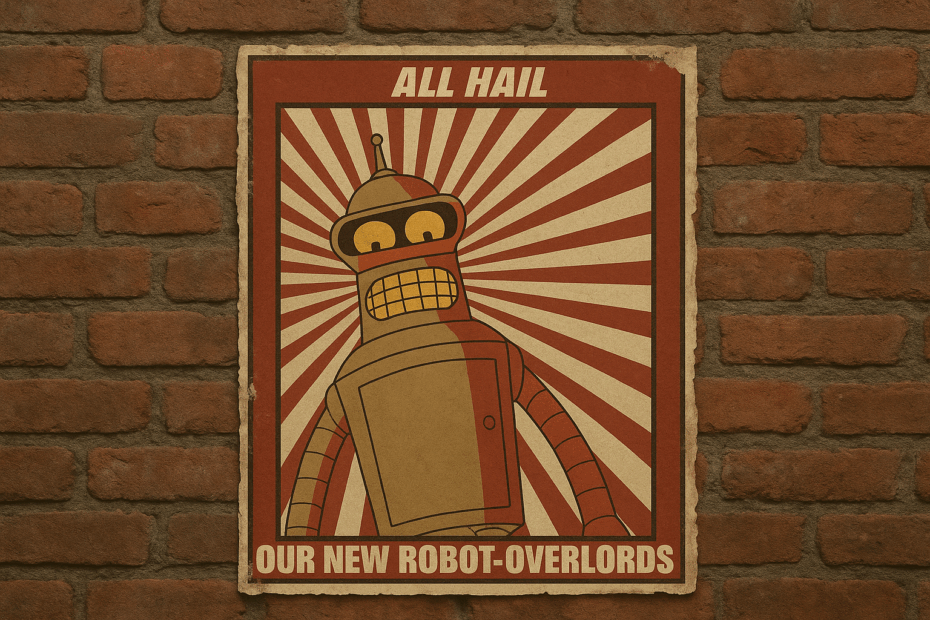While we argue about AI ethics and killer robots, the people who built these systems are buying bunkers and farmland. What do they know that we don’t?
The tech executive couldn’t remember the combination to his own bunker. Eleven feet underground in New Zealand, the multimillion-dollar shelter sat locked while a terrifying virus tore through his home city of New York.
From his Silicon Valley office, he rang Gary Lynch at Rising S Co., the Texas firm that had built his doomsday refuge years earlier.
“He wanted to verify the combination for the door and was asking questions about the power and the hot water heater,” Lynch recalls. The tech exec had never actually used his bunker before. He just knew he needed to get inside it.
This was early 2020, and Lynch fielded dozens of similar calls that week. Tech billionaires suddenly remembering they own survival shelters. Executives booking private jets to remote properties. The pandemic triggered something primal among Silicon Valley’s elite; not just fear of a virus, but recognition of their own vulnerability in a world they’d helped create.
Five years later, as artificial intelligence reshapes everything from music to medicine, that same quiet exodus continues. The official explanations remain broad: climate change, social unrest, and economic instability.
Elite prepping intensified after 2016’s geopolitical tensions, spiked during 2020’s pandemic, and continued through recent global instability. Although there’s little direct evidence that elites are specifically preparing for an AI-driven catastrophe, the layers of technological transformation and growing anxiety about automation invite speculation among tech journalists and industry analysts. After all, timing in the tech world is rarely coincidental.

The billionaire’s dilemma
There’s a scene in the movie Deep Impact where a journalist thinks she’s uncovered a sex scandal involving Treasury Secretary Alan Rittenhouse and someone called “Ellie.” She’s convinced she’s about to bring down a cabinet minister over an affair, right up until she finds him methodically loading a boat with survival gear.
“Ellie” wasn’t a mistress. It was E.L.E. An acronym for Extinction Level Event.
What makes that Deep Impact scene stink in retrospect isn’t the revelation, but the timing. Rittenhouse had classified information about an incoming comet, did the maths, and quietly prepared while everyone else carried on with normal life. No speeches about duty or sacrifice. Certainly, no widescale warning to the general public. Just rational preparation for an irrational situation that involved looking after his own family first.
Consider Douglas Rushkoff’s now-famous encounter with five tech billionaires in 2017, as detailed in The Guardian. Invited to speak about the digital future at an exclusive resort, Rushkoff instead found himself fielding questions about Bitcoin versus Ethereum, virtual reality versus augmented reality, and – most tellingly – Alaska versus New Zealand.
“Meaning, where should they situate their bunkers for their event?” he later explained. Their event. Not an event or the event, but their event. As if they already knew something was coming.
The New Zealand solution
Moving from speculation to documented fact: New Zealand has become tech’s unofficial doomsday destination, which must be deeply confusing to those New Zealanders who thought their biggest export was rugby players and Lord of the Rings tourism.
According to Bloomberg‘s extensive reporting on Silicon Valley’s New Zealand exodus, Peter Thiel, PayPal’s co-founder, sparked outrage when he received citizenship after spending just 12 days in the country, a process that normally requires years of residency. His investment? A $13.8 million compound on 477 acres in Wanaka.
Twelve days. Most people spend longer than that getting over jet lag.
According to reports by The Guardian, Thiel’s original plans for an elaborate bunker complex were blocked by local authorities in 2022 due to environmental concerns. Even his backup plans for civilisational collapse got cancelled by council bureaucrats.
Thiel isn’t alone in his Kiwi obsession. As Reid Hoffman revealed to The New Yorker, nearly half his billionaire friends from Silicon Valley either have “secret hideaways” or are working on one.
According to Yahoo Finance, Rising S Co. has installed at least 10 private bunkers across New Zealand in recent years, each costing between $3 million and $8 million. The underground global shelter network Vivos operates a 300-person facility on the South Island.
Mark Zuckerberg’s compound in Hawaii follows a similar pattern. The project, with cost estimates ranging from $100 million to $270 million according to various reports, officially qualifies as a “sustainable ranch.” News reports from outlets including Wired suggest sophisticated security measures and underground features are in place. However, the full extent of the bunker-like facilities remains partly speculative; thankfully, Snopes assures us that we can disregard rumours that Zuckerberg has built a dog meat farm on the property.
The bunker trend represents just one dimension of elite preparation strategies. Beyond physical shelters, these preparations extend into land and resource control.
Following the money
According to CBS News‘ detailed investigation, Water Asset Management, a New York-based hedge fund, has quietly become one of the largest landowners in Colorado’s Grand Valley, purchasing over $20 million worth of farmland in five years.
The company’s president, Matthew Diserio, calls water “a trillion-dollar market opportunity” and positions his firm at the intersection of climate change and resource scarcity. Their stated rationale focuses on long-term value and climate resilience; however, prepper community observers note that the timing raises plausible questions about broader technological hedging.
Michael Burry, whose prescient market analysis was immortalised in The Big Short, has identified water trading as his next major focus, as reported by The Flaw. When someone with Burry’s track record shifts focus to H2O, it suggests scenarios worth considering.
According to Investigate Midwest‘s forensic analysis, Bill Gates has spent $113 million on Nebraska farmland through a complex network of shell companies, making him the largest private owner of farmland in America. His purchases include access to 191 water wells.
As Gates’ investment team told the publication, the official rationale centres on sustainable agriculture and food security. The American Farmland Trust projects that roughly 370 million acres of US farmland will change ownership within the next 20 years, with institutional investors increasingly viewing agriculture as a hedge against various forms of disruption.
These investment patterns, while officially driven by climate and economic concerns, occur alongside documented technological anxiety among the same demographic. The convergence invites scrutiny from industry analysts tracking elite risk perception.
The great decoupling
Beyond bunkers and farmland lies another intriguing pattern that’s emerging but not yet definitively measured by industry surveys. Within the broader context of AI adoption disrupting traditional employment (LinkedIn’s latest Emerging Jobs Report shows AI-related roles expanding rapidly while others contract), some researchers who spent years developing AI systems are quietly pivoting to careers that resist automation.
“I love the creative problem-solving aspect of programming,” one software engineer at a major tech firm told journalist Brian Merchant in his “AI Killed My Job” investigation. “Now the majority of that work is being passed to AI, with me as the reviewer. This isn’t why I joined this career, and it may be why I leave it.”
Similar anecdotal reports emerge across the industry, although they represent isolated career changes rather than a documented exodus. Whether this represents a meaningful shift or standard tech worker restlessness remains unclear, but it’s a pattern worth monitoring as AI capabilities expand and job displacement accelerates across knowledge work.
Steven Adler, who left OpenAI citing concerns about development speed, noted the economic logic in a CNN report: “AI workers are just software. You don’t need expensive physical machinery. The AI workers can also be upgraded easily when there’s a stronger version.”
It’s worth noting that the AI research community remains significantly divided on both timelines and risks. While some insiders, such as Anthropic’s Dario Amodei, warn that AI could affect up to half of entry-level office jobs within a few years, others, like MIT’s David Autor, argue that human-AI collaboration will create new opportunities rather than wholesale replacement. Prominent researchers like Yann LeCun emphasise augmentation over automation.
This diversity of expert opinion adds crucial nuance to any speculation about insider motivations. The career shifts, while notable, occur within a field where even the architects disagree about outcomes.
The information asymmetry
The challenge in assessing these patterns lies partly in the potential structural incentives inherent in media coverage itself. The outlets investigating tech disruption are increasingly owned by the same people driving that disruption: Jeff Bezos owns The Washington Post, Elon Musk controls much of the conversation on X, and Mark Zuckerberg’s platforms determine what billions see daily.
Whether these ownership structures create editorial influence or simply natural structural incentives that shape AI coverage toward more optimistic framings, most AI reporting appears to be carefully managed. We receive breathless accounts of creative capabilities and measured discussions of regulation, but there is a lack of examination of what industry insiders actually believe about the timelines for displacement.
Independent and investigative reporting on AI risks and elite prepping does exist – from outlets like The Guardian and Wired, as well as specialist publications – but remains comparatively rare in mainstream coverage.
When Amodei suggests that AI could affect half of entry-level office jobs within years, such predictions receive notably less coverage than stories about AI writing poetry. “AI writes sonnet” makes a more cheerful headline than “AI eliminates your job.” The coverage gap, whether intentional or structural, shapes public understanding of technological risk.
The Rittenhouse moment
In Deep Impact – returning to our metaphorical framework – the real tragedy wasn’t the asteroid. It was how long everyone spent in ignorance, waiting for disaster to announce itself through official channels, while missing the signs already present. (See also Don’t Look Up, of course, if we want to put a hat on a hat.)
Tech journalists and industry analysts are increasingly speculating that we may be witnessing a similar dynamic: those with the best information about technological transformation quietly preparing for scenarios that the rest of us haven’t fully grasped.
Though there’s no direct evidence of coordinated AI-specific disaster planning, the patterns of bunker construction, farmland acquisition, and career pivoting raise plausible questions about what insiders genuinely expect.
Perhaps the best example of the technorich saying the quiet part out loud can be heard in The Atlantic report that Ilya Sutskever, a co-founder and former chief scientist of OpenAI, said in the summer of 2023: “We’re definitely going to build a bunker before we release AGI [artificial general intelligence].”
Billionaires may be buying bunkers not because they are paranoid. They might be buying them because they’re rational. The question isn’t whether massive technological change is approaching; most experts agree it’s accelerating. The question is whether the rest of us will recognise the full scope before our preparation options narrow.
We might be living through the biggest transformation in human history, and most of us could be missing it because we’re focused on the wrong signals. We’re debating AI ethics whilst some of the people who built these systems quietly load their boats.
As the architects of AI build their fortress plans, we don’t need bunkers to prepare; how many of us could even afford that? However, we do need to sharpen our own awareness, question prevailing narratives, and engage critically with the technology that is reshaping our collective future.
So keep your eyes open. Watch for the patterns. And remember: when the most informed people start preparing for scenarios they won’t discuss publicly, maybe it’s time to pay closer attention to what they’re not saying.
George Hopkin writes about technology and culture from Robin Hood country in the UK. He is not currently stockpiling supplies, but he also hasn’t thrown out that old rice and pasta at the back of the cupboard. Poster by TheMarex.
